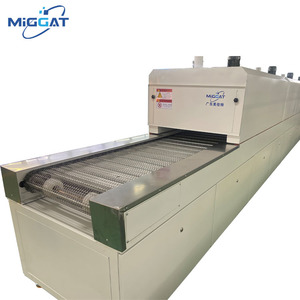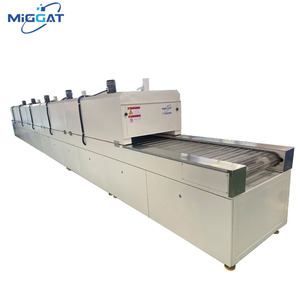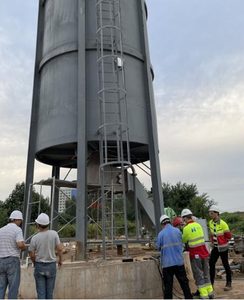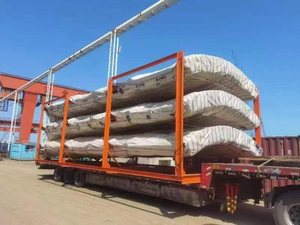
All categories
Featured selections
Trade Assurance
Buyer Central
Help Center
Get the app
Become a supplier

(1012 products available)



















A stress-relieving furnace is an industrial heating equipment used to reduce internal stresses in metal components, improve their mechanical properties, and enhance their overall performance. Various types of stress-relieving furnaces exist for different purposes and applications.
Both pit and walk-in types are classified as box furnaces, as they are designed in a box-like shape. Other box models include the vault type, whether arch or rectangle, which has a vault-like structure. Arch vault box models are often suitable for small areas with limited space. Additionally, there's the top-opening type, which has a cover on top and is open on all four sides.
Based on the heating method, stress-relieving furnaces can be categorized into electric resistance heating and others. Electric resistance heating is the primary way to generate heat in stress-relieving furnaces. It relies on electrical resistance wire to produce heat. Induction heating uses electromagnetic fields to heat metal components directly. It heats metal uniformly and is ideal for high-production applications. Gas-fired furnaces use natural gas or propane as fuel. They are suitable for large-scale applications that require high-temperature heat treatment. Additionally, there are also solar or plasma-based methods.
Specifications of a stress relief furnace kiln vary from manufacturer to manufacturer depending on the type and model of the stress relief kilns. The following are some of the common specifications of stress relief furnaces or kilns.
Maximum Temperature
The maximum temperature of a stress relieving furnace indicates the highest temperature the kiln or the furnace can reach. This is typically a range between 550 degrees celsius to 700 degrees celsius. The temperature ranges in a stress relief furnace is important because the alleviating stresses in the component material only occurs at particular temperature ranges.
Heating Rate
The heating rate of a stress relief furnace denotes how quickly the device can achieve its maximal temperature. This rate may differ depending on the kind and model of the kiln or the stress relief furnace (SRF). Typically, it varies from 5 to 20 degrees celsius per minute. To reduce distortion and damage in the material components, it is very important to attain the stress relief temperature in the material components in speculated optimum times.
Furnace Size and Capacity
The size of the stress relief furnace is often indicated by load capacity and physical dimensions. This helps in determining the SRF equipment that is suitable for the application of a particular industry. It also ensures that the material components of a given industry can easily fit in the furnace without any complications. For example, the industrial stress relief furnaces often have large dimensions and high capacity. On the other hand, laboratory stress relief furnaces have lower capacities and smaller dimensions.
Furnace Atmosphere
The furnace atmosphere indicates the kind of environmental setting the stress relief furnace entails. This includes the inert, oxidizing, vacuum, or reducing atmosphere. A specific material can only be utilized or an application can use only a kind of furnace atmosphere. For example, to prevent oxidation and contamination of the material, a protective gas might be used.
Energy Source
The energy source is the kind of fuel or power used in the manufacturing and functioning of the stress relief furnace. This could be natural gas, propane, electricity, diesel, hydrogen, among others. The particular energy source and setting are crucial to determining the effectiveness and environmental effect of the operation of the stress relief furnace.
Maintaining a stress relieving furnace is essential for its longevity and optimal performance. The following are some of the typical maintenance practices for a stress relief furnace:
Regular Inspections:
Industrial facilities carrying the stress relief furnaces often, at least weekly, visually inspect the device. The manufacturers or maintenance team usually look for any obvious damage, signs of wear, or abnormalities that are out of the ordinary in the stress relief furnace. The electrical connections and gas lines are checked for leaks or loose connections. Malfunctions in the kiln's components, such as the heating elements, fans, and pumps, are checked for. Stress relief furnace users can easily discover threats before they become a catastrophe and end up harming the device or the operator. This helps with the overall safety of an industry.
Lubrication:
Stress relief furnaces are usually equipped with moving parts like gears and motors. Such moving parts require regular lubrication. SRF users can ensure longevity and smooth movement by regularly lubricating the moving parts.
Industry sectors use the stress-relief furnace application in various ways. This includes stress relieving annealing furnaces used to improve the ductility and workability of metal components.
Steel construction and fabrication
In the steel construction industry sector, structural steel components undergo stress relieving treatment using stress relieving furnaces before being deployed in construction projects. These stress relieving treatments allow structural steel components to attain improved workability, ductility, and resilience against sudden impacts and stress concentration. This also significantly lowers the risk of any structural failure resulting from unanticipated brittle fracture or strain.
Automotive manufacturing
Automobile manufacturing industries also utilize stress relieving furnaces, like the aluminum stress relieving furnace, for stress-relief treatments of parts like suspension components, chassis, transmission housings, and engine blocks. Automotive manufacturers can attain better fracture resistance and structural integrity and lessen the risk of failure in automotive components by deploying a stress-relieving furnace in the production of automotive parts.
Airspace industry
Like automotive manufacturing industries, the aerospace industry also employs stress relieving furnaces in the manufacturing process of high-precision aerospace components. This includes aerospace components like turbine blades, landing gear, housings, and structural elements that are made of high-stress materials like titanium and aluminium alloys. The aerospace industry can enhance the ductility, strength, and toughness of critical aerospace components by subjecting these high-precision components to stress relieving treatments in a stress relieving furnace. This also assists in ensuring the safety and performance of the aerospace machinery.
Tool and die making
The tool and die making industry utilizes stress relieving furnaces during the manufacturing of high-precision tools and dies used in stamping, molding, and machining operations. This helps relieve internal stresses in tool steel materials, thus enhancing the durability, stability, and accuracy of the tools and dies.
Metal fabrication
In metal fabrication, companies can stress relieve welded assemblies and machined parts using a stress relieving furnace after challenging fabrication processes like welding and heavy machining. Stress relieving in this scenario reduces distortion, internal stresses, and cracks, thereby allowing better dimensional control and stability after fabrication.
Determine requirements:
Before purchasing a stress relieving furnace, it is wise to determine its stress relieving requirements. Some materials may have complex geometries, while others may have high levels of residual stress that need to be relieved. It helps to know precisely what is required before purchasing the equipment to avoid ending up with an ill-suited furnace for one's needs.
Consider the type of furnace:
When choosing a stress relieving furnace, it's essential to consider the type of furnace and its heating mechanisms. Options include batch or continuous furnaces, electric or gas-powered, and air or vacuum environments. Depending on manufacturing scale and material properties, one may prefer batch over continuous for smaller quantities. Electric provides more precise control than gas but may cost more, while a vacuum offers cleaner results at a higher price point.
Think about the size and capacity:
It is essential to consider the size and capacity of the stress relieving furnace. This decision depends on the quantity of materials that need to be processed. It's important to note that larger stress relieving furnaces may occupy more floor space. Hence, it is wise to strike a balance between capacity and space requirements.
Evaluate the energy efficiency:
When choosing a stress relief furnace, it helps to evaluate energy efficiency. Opting for an energy-efficient model can significantly reduce operating costs. It may help to consider features like automatic shut-off, insulation, and temperature controls.
Assess safety features:
It's essential to prioritize safety when choosing a reliever furnace. This is because these stress relieving furnaces are often used at high temperatures. Consequently, it's crucial to ensure that the furnace has safety features such as overheat protection, door interlocks, and emergency shut-off.
Think about the maintenance requirements:
When choosing a stress relieving furnace, consider the maintenance requirements. Opting for a furnace with less demanding maintenance can make life easier in the long run. It may help to consider the available support and services from manufacturers in case of an issue.
Check customer reviews:
Before purchasing a stress relieving furnace, it's essential to check out customer reviews. This research provides insights into the performance of the furnaces and any potential issues. It is crucial to take time to read and research before purchasing to ensure one makes an informed decision.
Q1. Why is it important to relieve stress in materials?
A1. The material's internal stresses can result in unfavorable consequences, such as distortion during subsequent processing or degradation of structural integrity.
Q2. What types of materials typically undergo stress-relief treatments?
A2. Metals such as steel, aluminum, titanium, and alloys are the primary materials that undergo stress-relief treatments. However, certain non-metallic materials, such as ceramics and composites, might also require stress relief.
Q3. Can all materials be subjected to stress relief through heating?
A3. No, not all materials can be stress-relieved through heating. Some materials may have low melting points, making them unsuitable for heat treatment.
Q4. What are the trends in stress-relieving treatments?
A4. The trend is toward more automated processes, with furnaces equipped with computerized controls and data logging to ensure consistent stress-relief treatments and compliance with quality standards.